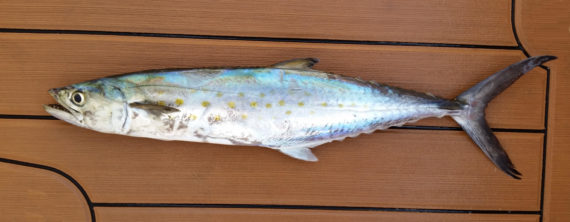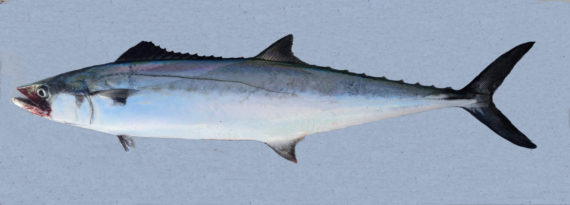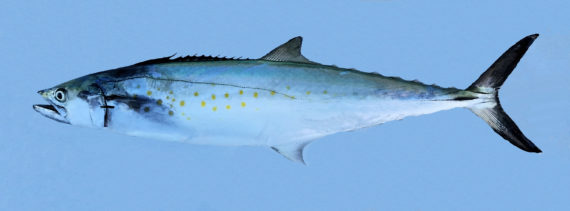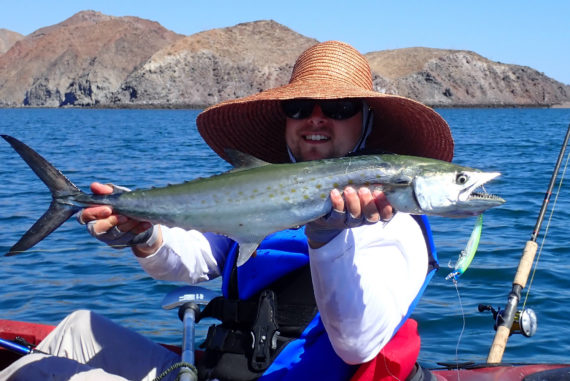Gulf Sierra, Scomberomorus concolor
 Gulf Sierra, Scomberomorus concolor, Juvenile, Female. Fish caught from coastal waters of Bahía de los Ángeles, Baja California, November 2010. Length: 25 cm (10 inches). Catch, photograph, and identification courtesy of Chris Wheaton, Fullerton, California.
Gulf Sierra, Scomberomorus concolor, Juvenile, Female. Fish caught from coastal waters of Bahía de los Ángeles, Baja California, November 2010. Length: 25 cm (10 inches). Catch, photograph, and identification courtesy of Chris Wheaton, Fullerton, California.
 Gulf Sierra, Scomberomorus concolor, Female. Fish caught from coastal waters off Puertecitos, Baja California, November 2014. Length: 46 cm (18 inches). Catch, photograph and identification courtesy of Eli (obsessiveangling.wordpress.com).
Gulf Sierra, Scomberomorus concolor, Female. Fish caught from coastal waters off Puertecitos, Baja California, November 2014. Length: 46 cm (18 inches). Catch, photograph and identification courtesy of Eli (obsessiveangling.wordpress.com).
 Gulf Sierra, Scomberomorus concolor, Male. Fish caught from coastal waters of Gonzaga Bay, Baja California, June 2017. Length: 61 cm (2 feet 0 inches). Catch courtesy of Earl Roberts, Mexicali, Baja California. Photograph, and identification courtesy of Chris Wheaton, Fullerton, California.
Gulf Sierra, Scomberomorus concolor, Male. Fish caught from coastal waters of Gonzaga Bay, Baja California, June 2017. Length: 61 cm (2 feet 0 inches). Catch courtesy of Earl Roberts, Mexicali, Baja California. Photograph, and identification courtesy of Chris Wheaton, Fullerton, California.
 Gulf Sierra, Scomberomorus concolor, Female. Fish caught from coastal waters of Gonzaga Bay, Baja California, June 2016. Length: 75 cm (2 feet 6 inches). Catch, photograph, and identification courtesy of Chris Wheaton, Fullerton, California.
Gulf Sierra, Scomberomorus concolor, Female. Fish caught from coastal waters of Gonzaga Bay, Baja California, June 2016. Length: 75 cm (2 feet 6 inches). Catch, photograph, and identification courtesy of Chris Wheaton, Fullerton, California.
 Gulf Sierra, Scomberomorus concolor, Female. Fish caught from coastal waters off San Felipe, Baja California, May 2015. Length: 78 cm (2 feet 7 inches). Catch, photograph, and identification courtesy of Chris Wheaton, Fullerton, California.
Gulf Sierra, Scomberomorus concolor, Female. Fish caught from coastal waters off San Felipe, Baja California, May 2015. Length: 78 cm (2 feet 7 inches). Catch, photograph, and identification courtesy of Chris Wheaton, Fullerton, California.
 Gulf Sierra, Scomberomorus concolor, Female. Fish caught from coastal waters of Gonzaga Bay, Baja California, April 2018. Length: 78 cm (2 feet 7 inches). Catch, photograph, and identification courtesy of Ben Cantrell, San Diego, California.
Gulf Sierra, Scomberomorus concolor, Female. Fish caught from coastal waters of Gonzaga Bay, Baja California, April 2018. Length: 78 cm (2 feet 7 inches). Catch, photograph, and identification courtesy of Ben Cantrell, San Diego, California.
The Gulf Sierra, Scomberomorus concolor, is a member of the Mackerel or Scombridae Family, that is also known as the Monterrey Spanish Mackerel and in Mexico as sierra golfina. Globally, there are eighteen species in the genus Scomberomorus, of which five are found in Mexican waters, three in the Atlantic and two in the Pacific Ocean.
The Gulf Sierra has an elongated, fusiform, and strongly compressed body. They exhibit sexual dimorphism as males are metallic blue dorsally, transition to silvery ventrally, and have no bars, spots or stripes, whereas females are darker metallic blue dorsally, transition to silvery ventrally, and have 2 series of alternating gold spots on their sides. Their ventral fins are clear to transparent and their other fins are dusky to very dark. Their snout is short and less than half the length of the head. Their mouth is equipped with a set of strongly compressed teeth that are triangular and knife-like. Their anal fin has 19 to 23 rays followed by 6 to 8 finlets; their caudal fin is deeply forked; their first dorsal fin has 15 to 17 spines; their second dorsal fin, set close to the first has 16 to 20 rays followed by 6 to 9 finlets; and, their pelvic fins are relatively short. They have 21 to 27 gill rakers. Their body is covered with small scales and their lateral line gradually curves down toward the caudal fin base.
The Gulf Sierra is a coastal highly migratory pelagic schooling species found from the surface to depths up to 15 m (50 feet). They reach a maximum of 87 cm (2 feet 10 inches) in length and 3.6 kg (7.9 lbs) in weight. As of January 1, 2024, the International Game Fish Association world record stood at 2.95 kg (6 lbs 8 ounces) with the fish caught by my good friend Chris Wheaton within Gonzaga Bay, Baja California, October 2021. I have a report of a 4.2 kg (9 lb 4 oz) fish being caught in coastal waters off San Felipe, Baja California in 2015. They inhabit coastal estuaries and marshes during the winter months and retreat to deeper cooler waters during the summer. They are voracious predators and consume small fish including anchovies, clupeids, and herrings. They are believed to have a lifespan of up to 8 years. The Gulf Sierra is poorly studied with very limited information available about their lifestyle and behavioral patterns including specific details on age, growth, longevity, movement patterns, diet, habitat use, and reproduction. They are a very rare and have fished to extinction in some parts of their historical range.
The Gulf Sierra is a resident of Mexican waters of the Pacific Ocean but has a limited range being found only in the northern two-thirds of the Sea of Cortez ranging south as far as Bahía Concepción, Baja California Sur.
The Gulf Sierra is easy to recognize. It is very similar to the Spanish Mackerel, Scomberomorus maculatus, found in the Atlantic. Females can possibly be confused with the Pacific Sierra, Scomberomorus sierra (3 to 8 rows of yellow spots; 12 to 17 gill rakers).
From a conservation perspective the Gulf Sierra is currently considered to be VULNERABLE and subject to possible extinction with an 80% reduction in their population documented over the last 40 years accompanied by a significant range reduction. They are caught on a very limited basis by artisanal fishermen in the central and northern portions of the Sea of Cortez. They are considered an excellent food fish if consumed the day of catch as they have a short shelf-life. Historically they were targeted and caught in great quantity by commercial gill net fishermen. Such practices continue today without any effective form of regulation in place. Efforts to introduce this fish to the Salton Sea in 1950 failed.